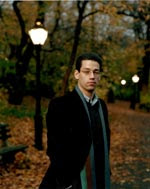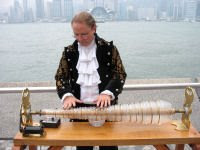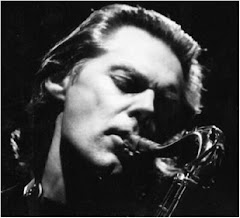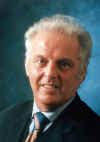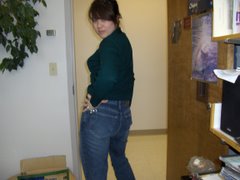 Joshua Bell
Joshua Bell with his Gibson Stradivarius. The story of how this violin came to Joshua is fascinating.
HISTORY OF JOSHUA'S VIOLIN
THE GIBSON STRADIVARIUS: FROM HUBERMAN TO BELL
The Gibson Stradivarius, one of the world's great violins, is now owned and played by Joshua Bell. In 1985 this instrument resided incognito for months in the Danbury home of Edward Wicks, where its "owner" Julian Altman, who was on his way to jail, had brought it for safekeeping. Within months of his imprisonment, Altman was near death from stomach cancer. On his deathbed, according to his wife, he divulged that the violin he had played for nearly 50 years was the Gibson Stradivarius that had been stolen in 1936 from the Polish violinist Bronislaw Huberman. The fascinating story of the Gibson Stradivarius has been told before.
Here, for the first time, is the complete story, including the important part that Edward Wicks played as a guardian for the violin on its journey to Joshua Bell. A somewhat shorter version of this story was published in the Danbury News-Times on April 18, 2004. In my research, I was able to confirm some facts previously uncertain (for example, that Altman had indeed played with the National Symphony). As a former research librarian, I am confident that this is as close to the "real story" as one can get at this time.
-- Jim Pegolotti
Librarian Emeritus, Western Connecticut State University
The Theft
The violins produced and shaped by the hands of Antonio Stradivari (1644-1737) have never been bettered, and since only some 600 of the 1100 Stradivarius instruments (mainly violins, but also violas and cellos) remain, the possession of one of these instruments is an absorbing ambition for some violinists. The traditional way to gain a Stradivarius is by purchase, but there is another method --- by thievery. This tactic occurred during a concert at Carnegie Hall on Friday evening, February 28, 1936, when the Gibson Stradivarius (named for an earlier owner) disappeared from the Carnegie Hall dressing room of its then owner, the Polish violinist Bronislaw Huberman (1882-1947). It happened while the violinist was on stage performing and playing his other exceptional violin, a Guarnerius.
After intermission, Huberman's secretary noticed the Stradivarius was missing from its case in the dressing room. It was "déjà vu all over again" because once before the violin had been stolen from Huberman in 1919 in Vienna, but was returned in only a few weeks. Rushing to the wings, the secretary got word to Huberman about the missing violin before the concert was over. Huberman, knowing the violin was insured, told her to call the police immediately, probably hoping for a result like that in Vienna --- a quick recovery. The police descended upon Carnegie Hall, but in spite of a lengthy investigation, the Gibson Stradivarius did not reappear. Lloyds of London, its insurer, eventually paid Huberman $30,000 (£8000), the then value of the violin, and thereby becoming the violin's owner should it ever resurface. For the fifty-one years that followed the theft, the Gibson Stradivarius simply vanished.
How Edward Wicks Came To Danbury And Became a Luthier
On Saturday, the day after the violin's disappearance from Carnegie Hall in 1936, twelve-year-old Edward Wicks was helping in his father's welding shop near their home in Flushing, Queens. The Wicks family was musically attuned with Mrs. Wicks playing the piano and her husband making valiant attempts on the French horn. Young Ed also had taken piano lessons, but had more fun learning to play the mandolin. With such musical interest, very likely the family was intrigued that morning with the two articles in the New York Times, both on the same page: one was a review of the Huberman concert, while the other headlined "Huberman Violin Stolen At Carnegie."
As years passed and the family business grew on Long Island, Ed found that he had inherited his father's innate sense of inventiveness and tinkering. It was a gift that would lead him in the second half of his life to become a luthier, a repairer of bowed stringed instruments. That happened after he married Ann Martinus. In 1950, the entire Wicks family, metal working business and all, moved to Danbury, where Ed remained part of the family business.
Ann, a singer trained at Juilliard, brought a major musical influence into the family's home, an enormous building in southern Danbury on the Redding line that became known as Wicks Manor. But it was John Burnett, a violinist who came to the Danbury area in 1936, who sent Ed off in a direction that would ultimately bring the Gibson Stradivarius to his home.
John Burnett in 1946 became the conductor of the Danbury Symphony, then known as the Danbury Orchestral Society. The short, prominent-chinned Burnett, an excellent violinist who had studied at Juilliard and the Royal Belgian Conservatory, energized the Danbury area musically; he was both an influential teacher and conductor. Of lasting importance was his initiation in 1957 of a training orchestra, the Danbury Little Symphony, now the Danbury Community Orchestra. Not unexpectedly, many in the orchestra were his own string students.
When Ed and Ann determined that their eight-year-old daughter Joan should learn to play the violin, John Burnett became her teacher and he came to know Ed better. Sensing musical gifts yet undeveloped, Burnett convinced him to learn to play the cello. From his basement, the teacher unearthed a "rough and chewed-up" cello for his soon-to-be protégé. Ed recalls that Burnett could almost be a martinet in his demands on his students, particularly if he believed they had not practiced sufficiently since the last lesson. Even as an adult, Wicks felt the pressure of Burnett and practiced incessantly. Within six-months of first pulling a bow across the cello strings, Ed was playing in the Danbury Symphony.
At the same time, Ed began to tinker with the "rough and chewed-up" cello. With advice from Burnett, he took it apart and put it back together in far finer condition than before, yet all by "trial, error, and common sense." So it was that Ed Wicks in his late thirties began to repair stringed instruments, encouraged by Burnett who told him that to become a luthier would help save what was rapidly becoming a lost art. Many of the violinists in the Danbury Symphony were teachers in high school and welcomed Ed as advisor and repairer.
Fortunately for Wicks, he had the opportunity to examine Burnett's violin, one of the fine violins from the "Golden Age" of violin making in post Renaissance Cremona. Here in this town on the Po River plain of Lombardy, artisans named Amati, Stradivari, and Guarneri produced great violins, violas, and cellos. Burnett's violin was created by Girolamo Amati (1561-1630), whose son Nicola passed on the family violin-making secrets to his student Antonio Stradivari, who then added his own varnish secrets. Many fingers had plucked Burnett's Amati, but none more famous than those of Benito Mussolini, a former owner of the violin.
When Ed and Ann built a new home near Wicks Manor, Ed set aside a room for his new avocation and began to advertise in the yellow pages under "Musical Instrument Repair." It was this ad in 1983 that caught the eye of Julian Altman. The previous year he had moved to nearby Bethel and needed some work on the violin that had been the source of his income for decades.
Altman, who had studied at Juilliard, in the late 1930s had moved from his native New York City to Washington, D.C. From 1940 to 1944 he was a member of the National Symphony, but later made his money more as a strolling musician, gaining popularity as an entertainer for political events. After a failed marriage and never able to generate a lot of savings, Altman continued to live in the Washington area. There he met Marcelle Hall, a divorcee from Bethel with two grown children, who was working for a social service department in Maryland. They lived together from 1970 on. Then in 1982 they moved to a home Marcelle owned in Bethel, a residue from her previous marriage.
The First Incognito Visit Of The Gibson Stradivarius
When Ed Wicks responded to a knock on the door of his Danbury home one day in the summer of 1983, he didn't recognize the visitor. The stranger introduced himself: "I'm Julian Altman -- Altman, like the department store. I saw your ad in the yellow pages as a violin repairer." Wicks recalls the event in detail. "The man appeared to be quite nervous. At one time he had two different cigarettes going at the same time." Altman took his violin out of the case and indicated it needed a new bridge and a slight opening on the side seam needed attention. He also needed two bows rehaired.
Wicks immediately noticed that the violin's surface areas -- a light chestnut color with a reddish hue -- showed signs of a violin well utilized. As soon as he took Altman's violin into his hands, its overall form, its feel and weight, sent his thoughts whirling. He looked closer for a signature, then seeing it, spoke excitedly to Altman: "My God, this is a Stradivarius." The visitor quickly responded. "On no, just a copy. I've had it since I was a young man." Wicks was not convinced by the answer, but could hardly challenge the stranger, so he indicated he could do the necessary repairs, but it would take about three days.
Hearing this, the nervous man walked about the room, seeming to decide what to do. He spotted a framed copy of a patent just assigned to Wicks that very year. A brisk discussion about the invention seemed to reduce Altman's nervousness, and he started to divulge some of his history. He told of being a New Yorker and that some of his early adventures were as a musician on radio, where he and his sister, Sylvia, often played on radio station WOR in the late 1930s as a violin duo.
Altman finally agreed to leave the violin for the necessary work. Over the next few days Wicks fit the new bridge, repaired the open seam near the neck, and rehaired the bows.
Several days later, when Altman returned for the violin he immediately picked it up, put rosin on a bow, and ran through a few cadenzas to test it out. Altman's playing made it clear to Wicks that he was in the presence of a fine violinist. Wicks suffered through the next moments, worrying about the results of his repairs, for he still believed that this was no ordinary violin. Altman's reaction was not long in coming. The violinist stopped in mid-phrase, looked directly at Wicks and said: "My God, what did you do?" Ed's heart went into mild arrhythmia for a moment, but Altman quickly added: "It never has sounded this beautiful" and he strolled around the living room delighted with what he heard. (During the time that Altman played the violin, Ann Wicks had remained upstairs. After he had left, she came down. "Ed," she asked, "what was that? It sounded absolutely gorgeous." "Well," Ed replied, "I think what you just heard was a Stradivarius.")
Before Altman left, Wicks told him about the Danbury Symphony, in which he played, and invited him to join. The violinist indicated that he would, and Wicks promised to bring him to the next symphony rehearsal and introduce him to James Humphreville, the conductor. Altman did enter the Danbury Symphony and sat next to the concertmaster. At times he helped instruct the section in a variety of techniques and bowing.
According to Wicks, Altman was a charming man and a good conversationalist. Linked by their musical interests, Ann and Ed occasionally went out to lunch or dinner with Altman and Marcelle Hall, who though not his wife appeared on the surface to be just that. As fate would have it, the socialization would last less than two years. Early in 1985, while at dinner in a local Chinese restaurant, Altman complained often of stomach pains. Those physical pains became secondary to the agony that Hall brought upon him when she had him arrested for sexually molesting one of her granddaughters. The arrest and date for sentencing were kept out of the local papers, leaving the musical community unaware of what was to come.
The Second, and Longer, Visit to Ed Wicks of the Still Incognito Gibson Stradivarius
On March 20, 1985, Altman appeared at the Wicks's home, not with the single violin case of two years before, but with a double violin case containing two violins: the one that Ed had worked on and another. He also had a sealed cardboard box about a foot square. Ed provided the following receipt: "Holding for Julian Altman: one double violin case, two violins and four bows. One cardboard carton containing men's jewelry, cuff links, coins, gems, rings, watch and various items of jewelry." Altman's instructions to Ed were to hold onto the violins and box until further notice, and not to let anyone know he had them. He then divulged to Ed the story of his arrest and that in six days he would be sentenced. Wicks agreed not to say anything to anyone until the story broke.
Then in a surprise move, Julian and Marcelle flew to Las Vegas and were married on March 24, 1985. Upon their return, on March 26 Altman pleaded guilty to the charge of risk of injury to a minor in Danbury Superior Court, thus avoiding trial. He was sentenced to a year of incarceration, and taken to the Bridgeport jail on North Avenue.
To make her first visit to the man who was now her husband, Marcelle asked Wicks to drive her to the jail because she didn't know how to get there herself. Ed remembers the trip and the dejected face of Altman in the brief time he had to speak to him. In the car, on the return trip to the Danbury area, Marcelle repeated over and over: "Oh, that Julian. If I ever knew where that violin is." Ed said nothing.
On April 9, 1985, Altman wrote to Ed and informed him that he had been moved to the Litchfield jail where he found his new quarters "more tolerable than before -- thus giving me a better incentive to 'last-it-out' and to 'come through it all' -- per your advice…In any case, I always think of you as a very close, sincere and treasured friend."
Not long afterward, Altman's chance to "last-it-out" vanished with the diagnosis of stomach cancer in terminal stage. Word got to Ed about Altman, now moved to a guarded area of a Torrington hospital, where he was allowed only incoming calls. Wicks called him several times during Altman's final weeks of life. In one call, the ailing prisoner asked Ed to get him a lawyer. He complained a great deal about how Marcelle continually questioned him to find out where the violin was, in a manner Altman referred to as "vicious."
As Marcelle would reveal almost two years later, just days before he died Altman told her that the violin was indeed a Stradivarius. She would find corroboration of its being the one stolen from Huberman in material between the violin case and its canvas cover. He then told her that Ed Wicks had the violin.
Marcelle soon called Wicks and indicated she would come to get the violin. Ed wasn't so sure that he should give her the double violin case, with its two violins and bows, so he called the prison and spoke to the dying man. Altman told him that, yes, he should give the violins to Marcelle. Within a few days, Marcelle claimed the double violin case. She would later declare that at some point after retrieving the violin she looked under the canvas cover of the violin case and discovered the material about the Huberman theft: newspaper clippings from 1936 about the theft, and a portion of an article from the 1977 September edition of Strad magazine, with the story of the stolen violin highlighted in pink.
Julian Altman died on August 12, 1985 and was cremated. Marcelle, declared executrix of the estate, delayed a funeral service at St. James Episcopal Church in Danbury until November 2nd, which was followed by the burial in a Bethel cemetery. She sent a personal invitation to Ed and Ann to attend, which they did. At the service a violin lay on the altar. When Ed went to view the violin, he saw that it was definitely not the one he had worked on. As would later be revealed, Marcelle, soon after her husband's death, had contacted a lawyer, a cousin in Norwalk, and brought the violin to experts to confirm it as being a Stradivarius.
Altman's Widow Announces The "Truth" About The Violin
For nearly two years after Altman's death Ed Wicks would hear no more about the violin, but much was happening. Once experts verified it as the Gibson Stradivarius, Marcelle Hall and lawyers then spent over a year negotiating with Lloyds of London, the violin's owner, for a finder's fee. Lloyds ultimately agreed that upon the sale of the cleaned and restored Gibson they would provide Marcelle Hall with one-quarter of the violin's value. They chose the prestigious firm J. and A. Beare Ltd. of London to restore the Stradivarius.
On May 8, 1987, with the Lloyds agreement reached, champagne flowed at Hall's Bethel home in a party that "had been in progress more or less since the previous evening." An NBC television crew had been summoned to help break the story of the return to the musical world of the Gibson Stradivarius. Charles Beare, representing Beare Ltd., arrived in a limousine, along with two of Lloyds's lawyers, and got his first look at the long-lost violin that they were to take back to England. Later that year he described the event in an article for Strad magazine: "As I lifted the violin from its case, I didn't appreciate that Mrs. Hall and her friends and family were still in doubt about the violin's identity. Very slowly I said 'No --- problem', and it turned out that in the second or two between the two words Mrs. Hall almost died with disappointment. After that there was joy all round." On May 12, the News-Times published "This Violin Had Strings Attached," a lengthy story about the Gibson with comments from Hall about her life with Altman. Two days later the New York Times featured a front-page story, "A Stolen Stradivarius, a 51-Year-Old Secret," along with a photo of Altman serenading Muriel Humphrey, Senator Hubert Humphrey's wife.
When Ed Wicks read the reports of the violin's true origins, he recalled the day when he said to Altman, "My God, this is a Stradivarius." Seeing the violin displayed on several television programs, he immediately recognized it as the violin he had worked on and later guarded, for the bridge of the violin bore his signature touches.
In that summer of 1987, on the 250th anniversary of the death of Antonio Stradivari, the city of Cremona presented a six-week display of forty-eight Stradivarius stringed instruments. Charles Beare helped organize the event, which included Itzhak Perlman's Soil Stradvarius. Near it, the newly restored Gibson made its first appearance, viewed with special interest by Marcelle Hall, who had traveled to Italy especially to see the violin and celebrate its return to the musical world.
Norbert Brainin, a British violinist and a member of the highly esteemed Amadeus Quartet, purchased the Gibson Stradivarius soon after. On February 26, 1988, Marcelle Hall received from Lloyds of London her finder's fee: $263,475.75
A Legal Battle Over The Finder's Fee
What happened next led to years of litigation. Sherry Altman Schoenwetter, Altman's daughter by his first marriage, had occasion to review an accounting of her father's estate made to the Bethel probate court by Marcelle Hall, the executrix. Schoenwetter formally objected to the omission from her father's estate of the finder's fee. On October 11, 1991, after a hearing at which both Hall and Schoenwetter testified, Daniel W. O'Grady, the Bethel probate judge, ruled that Hall had to return the money to the estate. He stated that it was not for the court to rule on whether or not Altman had stolen the violin for "Altman never made clear to anyone how he came to possess the Gibson." The court had only to rule on whether Marcelle had correctly carried out her duties as executrix of Altman's estate. According to O'Grady, "The Gibson was part of Altman's personal property. Therefore, the violin as well as the right to any finder's fee passed to the Altman's estate at his death." He also ruled that Hall had to add 10% interest to the estate's value for every year since she had received the money.
Hall's lawyer then appealed the case to the Superior Court in Danbury. There Marcelle testified that her husband in the last days of his life had indeed told her how he came to possess the Gibson. First he told her that he had purchased it from a friend for $100. Then, closer to his death, Altman admitted he was the thief, executing a plan he and his adoring mother had concocted to bring him a violin necessary for his talent to be appreciated. They lived near Carnegie Hall, and he played music in the Russian Bear, a restaurant behind the auditorium. He had made friends with the stage door guards and would often give them cigars and tell them he'd guard the door while they stepped out for a smoke. During one of these times (and during a break from playing in the restaurant), he ran upstairs, grabbed the violin, and exited, hiding it under his Russian peasant outfit. Hall admitted to the Superior Court that she had told the insurance company only the first story (that Altman purchased the violin for $100) and not the second one (that her husband was the thief).
Judge T. Clark Hull of the Superior Court supported the probate court's decision that the violin was part of the estate. Pulling no punches, he stated that Altman's wife by keeping the finder's fee herself had committed a "diabolical deed" equivalent "to an unlawful theft of the estate's property." The decision was released on October 3, 1995. Hall's lawyers then appealed to the Connecticut Supreme Court. Fifteen months later on December 31, 1996, the five justices, in a 4-1 ruling, supported the original Bethel probate court. Here the legal battle ended, but by now Hall owed the estate a half million dollars in principal and interest.
On March 18, 1997, nearly ten years after Hall had received the finder's fee, she declared herself broke. The News-Times reported that she was now living in Claremont, New Hampshire. "There's no money," she stated. "How will they get money from me? I'm living on my Social Security. There's no victory here." According to Schoenwetter's attorney, Christopher Donohue, his client did not receive "one red cent" as a result of all the litigation.
Marcelle Hall died on June 18, 2001. The Claremont Eagle Times obituary, ostensibly written by Hall's family, made no mention of Julian Altman. Hall had divorced her first husband in 1970, but in the obituary her married life was summed up as follows: "She was predeceased by her husband, Robert Samuel Hall, who died in 1986."
Joshua Bell Gains Possession Of The Gibson Stradivarius
Joshua Bell now owns and plays the Gibson Stradivarius. As Bell, 36, moved up through the ranks of violinists to reach the top of his art, much of that time he owned and performed on another Stradivarius, the "Tom Tyler," the violin he played for the musical score of the movie The Red Violin. His desire to own the Gibson came after he had had the opportunity to sample its sound when he appeared in a concert with Norbert Brainin. Brainin graciously allowed Bell to play a bit on the Gibson he then owned. As Bell stated in an interview years later, "I thought it was the most amazing sounding violin I'd ever heard." The owner, seeing Bell's reaction, jokingly said: "Maybe someday you'll have this violin. Well, if you can come up with $4 million."
As fate would have it, in August 2001, Bell stopped at Beare's London office and learned that Brainin was about to sell the Gibson, not to a violinist, but to a German industrialist. "I was practically in tears," Bell recalled. Determined to own the Gibson, he contacted Brainin and within a few days had negotiated a price. To gain the necessary funds, he sold the Tom Taylor Stradivarius for a bit more than $2 million, and then managed to come up with the additional amount needed. Was it worth it? Well, his recording made with the Gibson Stradivarius is now the current best selling CD in classical music. Considering the history of the violin heard on the recording, the title is quite appropriate: Romance of the Violin.
Some Reflections On The Rediscovery Of The Gibson Stradivarius
Ed Wicks often thinks back on those days when he worked on the Gibson Stradivarius, but he remains puzzled about a key point of Marcelle Hall's testimony: that she discovered materials about the Huberman theft somewhere between the violin case and its canvas cover. In the court case brought by Altman's daughter, Marcelle Hall exhibited the materials: newspapers clippings dated Feb. 19, 1936 and the Strad magazine. Wicks can't believe he would not have noted the presence of newspaper clippings and a magazine article should they have been present in the double violin case left with him.
At the trial, what was presented as evidence was not the double violin case in which she had picked up the violin from Wicks, but "a leather case enclosed in a zippered protective canvas sheath," undoubtedly a case for a single violin. Altman's daughter recalls her father storing his violin in a single, not a double case. If Hall did discover the materials in a violin case, it would not have been in the double case that Ed Wicks describes. Where did she find them? Perhaps they were in a single violin case that he had left at home after he went to jail, or even in the sealed container.
How much credence could be put on any of Hall's testimonies? Consider the following. Cathy Mears, one of Hall's nieces began collaboration with her aunt in 1991 to produce a book about the reappearance of the Gibson Stradivarius. In court testimony, Mears stated that she ceased working with her aunt on the project as a result of "two inconsistencies in the story about the manner in which Julian Altman acquired the violin told to her on various occasions by Marcelle Hall." In an interesting addendum, Mears testified that "throughout the entire period of the collaboration, Marcelle Hall maintained that Julian Altman stole the violin."
Could it be that Hall knew that the violin was a Stradivarius for some time before Altman's death? It isn't that Altman wasn't playing his own game at times. For example, a friend of Altman's told a Washington Post reporter in 1987: "Julian would tell people that his violin was a Stradivarius, and they would just laugh at him. They thought he was kidding." Also a letter in the court file indicates that Altman's sister, Sylvia, had known of the theft from a recording she accidentally stumbled across. In it Altman and his mother discussed the theft. Hall could have gained the truth of the violin from Altman, even from pillow talk. After all they had been together for seventeen years before his death.
All speculation aside, Ed Wicks can help correct another error found in several recent articles about the Gibson's appearance when it resurfaced in 1985: that the violin was covered with "shoe polish," ostensibly to camouflage its true identity. Wicks states categorically that nothing like "shoe polish" was on the violin when he turned it over to Hall. Here is probably how the "shoe polish" story arose. When Charles Beare came to Bethel on May 8, 1985 to view and receive the violin for Beare Ltd, he made notes of the event. Later, in the Strad magazine article (December 1987), he described the Gibson Strad when he first saw it in Bethel:
"Out in the better light of the garden, away from the crowd and the popping champagne corks, I had a good look at Huberman's remarkable violin. In 1911, when the young virtuoso purchased it, Alfred Hill of W. E. Hill and Sons wrote 'The red varnish is in a pure state, as applied by the maker.' Now you could barely see it, submerged as it was beneath layer upon layer of dirt and polish. . . .Nevertheless the violin was clearly a masterpiece, and in the pale sunlight its handsome wood and red varnish glowed reassuringly."
Probably a reporter decided to add "shoe" to Beare's "polish" reference. In this way are mysteries compounded. In fact, this story has enough mysterious aspects so that no more need be added.
Will it ever be known how Altman acquired the Gibson Stradivarius and when Hall came to know of it? It's very unlikely. The truth is buried now in Claremont, New Hampshire and in Bethel, Connecticut with the two major players of the story.
The writer thanks Edward and Ann Wicks, Sherry Altman, Roseann Billeas of the Danbury Superior Court Law Library, Wayne McElreavy, who supplied the Hall obituary, and Ladd Library of Bates College for the loan of the book Capolavori di Antonio Stradivari by Charles Beare.
© James Pegolotti July 26, 2004
THE "GIBSON" STRAD OF 1713
Antonio Stradivari: The Cremona Exhibition of 1987 by Charles Beare
This violin, of flat, masculine build, an outstanding concert instrument, is famous for having been stolen from the Polish virtuoso violinist Bronislaw Huberman at Carnegie Hall, in New York, in 1936. Huberman had played a concert on his Guarneri, and on returning to his dressing room discovered that his treasured Stradivari had disappeared. No trace of it was found until spring of 1987, when it was offered to Lloyd's of London, the legal owners, by the widow of Julian Altman, a cafe violinist who claimed to have bought it for a modest sum the day after the theft.
W. E. Hill and Sons purchased the violin in the nineteenth century from an old French family, subsequently selling it to Alfred Gibson, a prominent English violinist who also owned one of the Stradivari violas exhibited in Cremona. In 1911 it returned to Hills and was sold to Huberman, at which time Alfred Hill wrote that "the fine red varnish which covers it is in a pure state as applied by the maker." Three months before the opening of the exhibition the varnish was almost unrecognizably submerged beneath layers of dark grime and shellac, but after a minor restoration and a very careful clean-up at J and A Beare it duly took its place, its deep red colour once more revealed for all to admire.
The violin's tone turned out to be absolutely outstanding, and in February 1988 it was sold by J and A Beare, acting on behalf of Lloyd's, to the well-known violinist Norbert Brainin, formerly of the Amadeus Quartet.
Copyright Text © Charles Beare 1993
A FAMED VIOLIN'S FANTASTIC JOURNEY
Long-lost Stradivarius strikes a chord in heart of modern master
10/28/2001
By Mark Wrolstad / The Dallas Morning News
The mystique of the name Stradivarius has resonated beyond classical music for generations, finding a place in the popular imagination and even urban legend.
You don't have to know a violin from a viola to know the stories - some apocryphal - about one of the exquisitely rare instruments turning up in an attic or junk shop.
Now add another stanza to what may be the most contorted tale of all the world's prized violins - a masterwork lost for half a century, today in the hands of a new master.
Joshua Bell, the young superstar violinist who played the solos for a movie about a violin's travels through the ages, took his role in the true-life version this month by paying nearly four million dollars for the famed Gibson Stradivarius, which is nearly three centuries old.
Dealers in Dallas who work for the leading restorer and seller of stringed instruments helped complete the sale.
"I instantaneously fell in love with the instrument like I never have before with a violin," Mr. Bell, 33, said Friday from his home in New York. "This is like a dream come true."
Mr. Bell, hailed for his lyric musicianship and varied musical interests that have made him an international crossover hit, bought a violin whose history is almost as dark as the grime that covered it when the instrument resurfaced after a deathbed confession in 1985.
The Strad -- a conversational abbreviation in concert and collector circles for violins made by Antonius Stradivarius - has been stolen twice, last disappearing from New York's Carnegie Hall in 1936.
Even after a cafe musician, dying in jail, admitted he had the stolen violin all those years, an insurer's payment to get it back led to litigation between the thief's heirs.
"It's a bit ironic that he's buying an instrument with so much intrigue surrounding it," said Michael Selman, general manager of J and A Beare Ltd. in Dallas, the company that sold the violin for well-known British violinist Norbert Brainin.
"If the movie The Red Violin hadn't been made, this would have been the one to write a book about," Mr. Selman said of the 1999 film in which Mr. Bell played the music.
Among the yarns of famous violins reappearing, Mr. Selman said, "This is the story, and it involves one of the very fine violins in the world."
This one was constructed in 1713, during what's known as the Golden Period - when Stradivarius made instruments renowned for unequaled tone.
The violin later became known as the Gibson Strad, taking its name from early owner Alfred Gibson, as is customary for valued instruments.
Of the more than 1,100 violins made during Stradivarius's lifetime, about half are thought to still exist. (Through the centuries, manufacturers around the world usurped the famous name, producing hundreds of thousands of violins stamped "Stradivarius" - explaining all of those garage-sale discoveries.)
Ninety years ago, the Gibson Strad was owned by Polish virtuoso Bronislaw Huberman, from whom it was stolen twice.
In 1919, the violin was taken from his hotel room in Vienna but was quickly returned after the thief supposedly offered it to a dealer.
The next time, Mr. Huberman didn't get it back.
He was on stage at Carnegie Hall in 1936 when the violin was stolen from his dressing room.
Eventually, he accepted a full settlement of about $30,000 from the insurer, Lloyd's of London.
For the next fifty-one years, the violin was officially missing, though it apparently frequented cafes and clubs in the New York area with a violinist named Julian Altman.
Its trail went undetected until 1987 when a sixty-nine-year-old widow with an evolving story contacted Lloyd's about the long-lost violin.
Marcelle Hall said Mr. Altman had revealed his lifelong secret in 1985 while dying of stomach cancer: He bought the Gibson Strad for $100 the day after a friend stole it from Carnegie Hall.
Mr. Altman died at age seventy shortly after he and Ms. Hall were married.
Lloyd's agreed to pay Ms. Hall a finder's fee of $263,475 -- one-quarter of its value.
A half-century of filth was lifted from the Strad - "like taking dirt off the Sistine Chapel," Mr. Bell said - and in 1988, the insurer sold it to Mr. Brainin for $1.2 million.
Nearly a decade later, Mr. Altman's daughter, Sherry Schoenwetter, gave up trying to get her share of Ms. Hall's payment. The Connecticut Supreme Court ruled in 1996 that Ms. Hall should have included the money in her husband's estate.
But Ms. Hall had spent the small fortune and had few assets left.
The lengthy court fight did elicit from Ms. Hall a second detailed account of the stolen Strad.
She testified that Mr. Altman confessed to stealing the violin in a plot concocted with his mother and that she found old newspaper stories about the theft in the violin case.
Mr. Altman, who was known around Carnegie Hall, had ducked out of his job with a gypsy orchestra at the nearby Russian Bear cafe, Ms. Hall said. He diverted a security guard with a fine cigar, went to the dressing room and hid the violin under his coat, she said. A trial judge described the testimony as "more dramatic than the most contrived TV mystery show."
Chris Donohue, Ms. Schoenwetter's attorney, said Ms. Hall's story was "probably true," but his client was never paid. "Not one red cent."
About the time the litigation ended, Mr. Bell appeared at a concert with Mr. Brainin and had his first encounter with the violin that one day would be his.
"He let me play a few notes, and I thought it was the most amazing-sounding violin I'd ever heard," Mr. Bell said.
He recalled the owner's joking response: "Maybe someday you'll have this violin. Well, if you can come up with $4 million."
Five years later, they met again - Mr. Bell and the Gibson Strad, that is.
In August, he stopped at Beare's London office and found that it was about to be sold to a German industrialist.
"It made me nauseous, the thought of that," he said.
He put the violin to his chin again and played. "I was practically in tears, and I said, 'You cannot take this violin.' "
Mr. Bell talked with Mr. Brainin. Negotiations took just two days.
"Which is very unusual," Mr. Bell said. "You usually spend months trying to make sure it's the right violin."
"I could only go so far with price, and I think he liked the fact that I'd be playing his violin."
Mr. Bell had to sell an old friend, his 1732 Strad, the one he played for the Oscar®-winning score of The Red Violin.
The escalating market for Strads quickly brought him more than $2 million from a collector who will lend the violin to a young performer.
The Gibson Strad, it so happens, has a "glorious varnish" that's "extremely red."
"It's ironic for me that I'm ending up with the red violin," Mr. Bell said.
It will be with him from now on, his performance violin on stage and in the studio, he said, making the promise of countless love affairs.
"Always."
Reprinted with permission of The Dallas Morning News.












































 Mickey Mouse,
Mickey Mouse,





